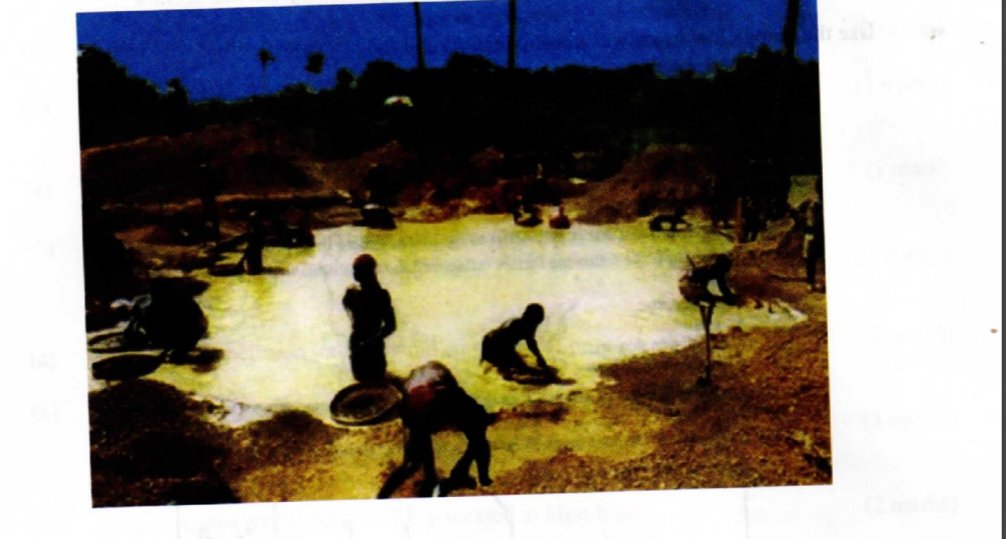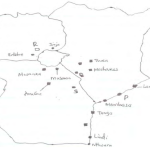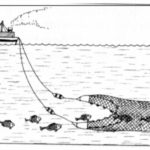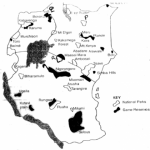KNEC KCSE Past Papers 2016 Geography paper 2 (312/2)
KCSE Past Papers 2016 Geography Paper 2
2016 Geography Paper 2
SECTION A
Answer all the questions in this section
1. (a) Name two exotic breeds of dairy cattle reared in Kenya. (2 marks)
(b) State three physical conditions that favour dairy farming in Denmark. (3 marks)
2. (a) Name the method of irrigation used in the Perkerra Irrigation Scheme. (1 mark)
(b) State three factors that influenced the location of the Perkerra Irrigation Scheme. (3 marks)
3. (a) Differentiate between transport and communication. (2 marks)
(b) State three causes of the decline in the use of letter writing as a means of communication in Kenya. (3 marks)
4. (a) Why is Kenya’s petroleum refinery located at Mombasa? (2 marks)
(b) State three ways in which the clearing of forests has affected the natural environment in Kenya. (3 marks)
5. (a) State three measures which the government of Kenya has taken to reduce infant mortality. (3 marks)
(b) Give three negative effects of low population growth in a country. (3 marks)
SECTION B Answer question 6 and any other two questions from this section
6. Use the map below to answer question (a) (i) and (ii)
(a) Name:
(i) The rivers marked E, F and G. (3 marks)
(ii) The human-made lakes marked H and J. (2 marks)
(iii) Explain four measures which should be taken to improve inland water (8 marks) transport in Africa.
(h) State four ways in which communication contributes to economic development in Kenya. (4 marks)
(c) Explain four problems facing railway transport in Africa. (8 marks)
7. Study the photograph below and answer questions (a) and (b).

(a) Name: (i) the mining method shown in the photograph; ( I mark)
(ii) two minerals that may be mined using the method shown in the photograph. (2 marks)
(b) (i) Using evidence from the photograph, give four indicators that show that the weather was hot when the photograph was taken. (4 marks)
(ii) Describe how minerals are obtained using the mining method shown in the photograph. (5 marks)
(iii) Citing evidence from the photograph, explain two ways in which the mining method shown has affected the environment. (4 marks)
(iv) Apart from the method shown in the photograph, name three other mining methods. (3 marks)
(c) Explain how the following factors influence the occurrence of minerals
(i) evaporation; (2 marks)
(ii) volcanicity; (2 marks)
(iii) metamorphism. (2 marks)
8. (a) (i) Name two settlement patterns. (2 marks)
(ii) Explain four physical factors that influence settlement. (8 marks)
(b) (i) Explain how the following factors have led to the growth of Thika.
• Location; (2 marks)
• Transport; (2 marks)
• Land. (2 marks)
(ii) Apart from being a transport and communication centre, give three other functions of Thika town. (3 marks)
(c) Explain three positive effects of urbanisation to a country. (6 marks)
9. (a) Identify three sources of renewable energy. (3 marks)
(b) (i) Name three main Hydro Electric Power stations along the River Tana. (3 marks)
(ii) Apart from providing electric power, state four other benefits of the dams along the River Tana. (4 marks)
(iii) Identify two problems that affect the production of power from the stations along River Tana. (2 marks)
(c) Explain four measures the Government of Kenya has taken to conserve energy. (8 marks)
(d) Some students carried out a field study on sources of energy by sampling households around their school.
(i) Identify two sampling techniques the students may have used during the study. (2 marks)
(ii) Give three advantages of sampling the household for the study. (3 marks)
(a) (i) What is visible trade? (2 marks)
(ii) List three major imports to Kenya from Japan. (3 marks)
(b) Explain four factors that influence internal trade in Kenya. (8 marks)
(c) State four ways in which trade is of significance to Kenya. (4 marks)
(d) Explain four benefits which member states of ECOWAS derive from the formation of the trading bloc. (8 marks)
Questions and Answers
2016 Geography Paper 1
No.1.(a) Name two exotic breads of dairy cattle reared in Kenya.
❖ Fresian / Holstein
❖ Ayshire
❖ Guernsey
❖ Jersey
❖ Alderney
❖ Brown Swiss / Swiss Brown (2 marks
(b) State three physical conditions that favour dairy farming in Denmark. (3 marks (Page 143 2007 Q.5)
❖ The landscape is gently sloping which is suitable for grazing
❖ The climate has warm / sunny summers / moderate temperatures (100 – ITC) that allow outdoor grazing.
❖ There is cool climate suitable for pasture growing
❖ The moderate rainfall (500-1000mm) that supports growth of grass / fodder crops
❖ Boulder clay soils are fertile support high pasture
No2.(a) Name the method of irrigation used in the Perkerra irrigation scheme (1 mark)
❖ Furrow / canal irrigation.
(b) State three factors that influenced the location of the Perkerra irrigation scheme. (3 marks (Page 150 2013 Q.7b)
❖ Availability of extensive land for irrigation.
❖ Availability of water from River Perkerra.
❖ The gently sloping land that allows mechanization/ easy flow of water for
irrigation by gravity.
❖ Presence of fertile loamy/ alluvial soils good for the growth of a variety of crops.
❖ Dry conditions/ semi arid/ unreliable/ low rainfall making it necessary to irrigate the area.
❖ The area is sparsely populated.
No. 3.(a) Differentiate between transport and communication. (2 marks)
❖ Transport is the movement of goods and people from one place to another while communication is the transmission of ideas of information from one person to another.
(b) State three causes of the decline in the use of letter writing as a means of communication in Kenya. (3 marks)
❖ The high rate cost of postage
❖ Competition from cheaper and faster means of communication
❖ The delay in the delivery of letters
❖ Loss of letters
❖ Tampering with letters
No. 4(a).Why is Kenya’s petroleum refinery located at Mombasa? (2 marks)
❖ It is easier to transport refined petroleum products than crude hence the need to process crude oil at the port of entry/ crude oil the raw material for the refinery comes by sea/it is cheaper to transport to the port of Mombasa/ closeness to the source of raw material/ Mombasa is the only port of entry.
(b)State three ways in which the clearing of forests has affected the natural environment in Kenya. (3 marks)
❖ It has led to reduced volume of water in the rivers / caused drying up of rivers.
❖ It has led to the destruction of the natural habitat of wildlife. It has endangered some of the wildlife species.
❖ It has led to changes in the rainfall pattern/ Desertification.
❖ It has interfered with the beauty of the environment / lowered the aesthetic value of the environment.
❖ It has disrupted the ecosystem
❖ It has accelerated soil erosion.
No. 6. Use the ma • below to answer questions a (i) and (ii)
a) Name (i) The rivers marked E, F and G
❖ E – R. Congo.
❖ F – R. Zambezi.
❖ G – R. Orange (3 marks)
(ii) The human-made lakes marked H and J.
❖ H – Kainji
❖ J – Nasser (2 marks)
(iii) Explain four measures which should be taken to improve inland water transport in Africa. (8 marks)
❖ The waterways should be dredged regularly to control siltation/ maintain constant depth of the rivers and lakes for easier navigation.
❖ Dams/ barrages should be constructed to control flooding hence allowing navigation.
❖ Constructing canals/ canalizing the rivers where waterfalls, rapids or rock outcrops exist to bypass obstacles that hinder navigation.
❖ Constant clearing/ controlling the growth of vegetation to allow free movement of vessels.
❖ Using modern vessels and equipment to improve the efficiency of handling cargo/ passenger service.
❖ Removal of rock obstacles from river beds to allow free navigation.
b) State four ways in which communication contributes to economic development in Kenya. (4 marks)
❖ Technological efficiency in communication makes business transactions easier/ faster.
❖ Modern communication networks allow for the spread of ideas/ information for decision making which enhances economic development.
❖ Communication promotes development of related industries/ business opportunities.
❖ Communication services provide employment opportunities.
❖ Communication connectivity promotes mobility of labour.
❖ Individuals/ Companies/ Government earns income / derives revenue from communication services.
❖ Communication facilitates marketing of products thus a wider market
c) Explain four problems facing railway transport in Africa. (8 marks)
❖ African countries use a different railway gauges which makes it difficult to have an integrated railway transport system/ transhipment of goods.
❖ Construction of railways requires large amounts of capital that most countries lack, either to extend or maintain the existing lines.
❖ Accidents/ vandalism/ uprooting of the railway line causes great losses/ delays in transportation.
❖ Tropical storm waters at times wash away vital sections of the railway lines thereby disrupting transport/ causes accidents.
❖ Railway transport faces stiff competition from the faster/flexible means of transport such as road and air transport hence under-utilization of railway facilities.
❖ Fuelling/ maintenance of railway stations and other related overhead costs are high thus reducing profit margins.
7.(a) i Name: (i) the mining methods shown in the photograph; (1 mark)
❖ Panning/ alluvial mining/ placer mining
(ii) two minerals that may be mined using the method shown in the photograph. (2 marks)
❖ Gold,
❖ Diamond,
❖ Platinum,
❖ Tin
(b) (i) Using evidence from the photograph, give four indicators that show that the weather was hot when the photograph was taken. (4 marks)
❖ Almost all the miners have removed their shirts/ bare chested.
❖ Some miners are wearing hats/ head scarfs
❖ The sky is clear.
❖ The shadows indicate that the sun is almost overhead.
❖ Use of an umbrella by a person at the middle ground.
❖ Bodies are glistering with sweat/ sweaty bodies.
❖ There is a reflection of the sun rays on the water surface .
(ii) Describe how minerals are obtained using the mining method shown in the photograph.(5 marks)
❖ A mixture of water, solid/ mud and mineral particles is scooped from the water bed using a pan. Water is added if the mixture is thick/ if the water is excess it is decanted.
The material scooped is swirled in the pan.
This separates the lighter material from the heavier particles which contain the mineral particles.
The lighter material is removed/ poured out. The heavier materials are sorted to display mineral particles. The mineral particles are collected from the pan.
(iii) Citing evidence from the photograph, explain two ways in which the mining method shown has affected the environment. (4 marks)
❖ The scooping of materials has led to water pollution as indicated by the brown colour stagnant water which may make it unfit for people to use.
❖ The continuous scooping and dumping of the waste has led to land dereliction as indicated by the depression and heaps of waste material.
❖ The method has led to destruction of vegetation as miners cleared the land to acces the area with the mineral as indicated by absence of vegetation/ bare ground/ in the foreground/ middle ground.
❖ The method has led to loss of biodiversity/ destroyed the ecosystem as indicated by the absence of plant life where mining is taking place
(iv) Apart from the method shown in the photograph, name three other mining methods.(3 marks) :
❖ Opencast/ stripping method,
❖ Deep shaft/ underground method/ solution.
❖ Add/ drift/ horizon/ tunnel method/ slope mining,
❖ Drilling method.
(c) Explain how the following factors influence the occurrence of minerals: (i) evaporation; (2 marks)
❖ High temperatures in arid and semi-arid areas cause evaporation of water in lakes/ seas. This leads to high concentration of mineral salts in the water. Continued evaporation causes further recrystallization of the salts which may thereafter be attracted as minerals such as soda ash and common salt/ deposition of salts near the surface
(ii) vulcanicity; (2 marks)
❖ When molten magma intrudes into rock joints minerals contained in the magma embedded in the joints called veins. Such minerals as tin and copper occur in this form/ Hot springs/ geysers. Fumaroles bring minerals to the earth’s surface
(iii) metamorphism (2 marks)
❖ High pressure and heat cause recrystallization and hardening of certain rocks causing them to change their nature to and become minerals such as diamond.
No. 8.a) (i) Name two settlement patterns. (2 marks)
❖ Nucleated settlement/ clustered
❖ Dispersed settlement /scattered
❖ Linear settlement
❖ Radial settlement
d.i) Explain four physical factors that influence settlement. (8 Marks)
❖ Areas that receive high reliable rainfall attract more people since they can engage in arable farming/ ares that receive low rainfall have fewer people as they are unsuitable for arable farming.
❖ Areas near water bodies attract dense settlements as the water is available for domestic/ industrial use /areas of scarcity water discourages settlement since it is difficult to get water hence low productivity.
❖ Areas with cool moderate temperature are densely settled as they can support agriculture / human life. Areas with extreme temperatures are sparsely settled as they are uncomfortable for human beings.
❖ Areas with fertile soils attract settlement as a wide range of crops can be grown / poor soils/ poorly drained soils are unsuitable for arable farming / are prone to water diseases.
(b) (i) Explain how the following factors have led to the growth of Thika town. – Location; (2 marks)
❖ Its proximity to Nairobi has led to industrial expansion as Nairobi acts as market to its products/ supplies
– Transport; (2 marks)
❖ It has a railway / road connection which provides easy movement of food/ people/ raw materials/ finished products
– Land. (2 marks)
❖ There is ample/flat land for development of industries/ settlement
❖ The cost of land is relatively cheap hence attracts investors
(ii) Apart from being a transport and communication centre, give three other functions of Thika town. (3 marks)
❖ It has a railway/ road connection which provides easy movement of food/ people
❖ It is an industrial center
❖ It is an educational center
❖ It is a commercial center
❖ It is an administrative center
❖ It is recreational center
❖ It is a religious center.
(c) Explain three positive effects of urbanization to a country. (6 marks)
❖ It encourages national unity as people of different nationalities come together and interact
❖ It promotes links between countries as communication networks tend to focus on and are more developed in urban centres
❖ It provides employment opportunities through the establishment of commercial and industrial activities which attract population that provide labour.
No. 9.(a) Identify three sources of renewable energy. (3 marks)
❖ Wind
❖ Sun
❖ Water
❖ Tides / waves
❖ Geothermal steam
❖ Biomass
❖ Wood/ trees
❖ Drought animals
(b) (i) Name three main Hydro Electric Power Stations along the River Tana. (3 marks)
❖ Masinga
❖ Kamburu
❖ Gitaru
❖ Kindaruma
❖ Kiambere
(ii) Apart from providing electric power, state four other benefits of the dams along the River Tana. (4 marks)
❖ The reservoirs provide water for domestic use /industrial use/ irrigation.
❖ The dams / reservoirs are tourist attractions.
❖ The reservoirs are fresh water fisheries.
❖ The reservoirs modify local climate.
❖ The dams act as bridges across the river.
❖ The dams and reservoirs control floods downsteam.
(iii) Identify two problems that affect the production of power from the stations along River Tana. (2 marks)
❖ Fluctuations of water levels in the reservoirs.
❖ Inadequate capital for maintenance / high cost of dredging/ expansion.
❖ Silting of the reservoirs
(c) Explain four measures the Government of Kenya has taken to conserve energy. (8 marks)
❖ Encouraging people to use renewable sources in order to reduce the over reliance on fossil fuels,
❖ Developing energy saving technologies in order to reduce the high consumption of energy,
❖ Enforcing the legislation against indiscriminate cutting down of trees for fuel thus conserving existing resources.
❖ Educating the public on the careful use of energy in order to save it.
❖ Progress taxation on energy consumption in order to discourage the misuse of energy,
❖ Proper planning of road networks in urban areas to reduce traffic jams hence saving on fuel consumption,
❖ Encouraging the use of public transport/ walking/ cycling/ railway in order to reduce the number of vehicles on the roads thus reducing energy consumption,
❖ Discouraging importation of high fuel consumption vehicles to reduce amount of fuel used.
❖ Encouraging afforestation/ reafforestation for continuous supply of wood fuel.
(d) Some students carried out a field study on sources of energy by sampling the households around their school.
(i) Identify two sampling techniques the students may have used during the study.(2 marks)
❖ Stratified
❖ Random
❖ Systematic
(ii) Give three advantages of sampling the households for the study. (3 marks)
❖ To save on time.
❖ To reduce bias.
❖ To allow for detailed study.
❖ To reduce cost.






